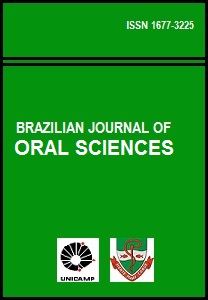Abstract
The purpose of this study was to compare the depth of tubular dentinal penetration of sealer in three filling techniques. Seventy two teeth maxillary central incisors were instrumented and randomly divided in three groups A, B and C and obturated as following: A: lateral condensation; B: single cone technique and C: warm vertical compaction of guttapercha. Each sample was sectioned longitudinally and prepared for SEM analysis. The results revealed a depth of tubular penetration varying from 19 to 81mm, presenting an average post of 34 ± 16mm for G1; 26 to 101mm, presenting an average post of 44 ± 28mm for G2 and 22 to 188mm, presenting an average post of 67 ± 37mm for G3. A non-parametric ANOVA Kruskall-Wallis was used to determine whether there were significant differences among the groups, which identified significant differences between G3 and G1 (P = 0.021) and between G3 and G2 (P = 0.009). There were no significant differences between G1 and G2 (P > .05). The samples filled by warm vertical compaction of gutta-percha presented significantly deeper tubular sealer penetration than lateral condensation and single cone techniquesReferences
White RR, Goldman M, Lin PS. The influence of the smear layer upon dentinal tubule penetration by endodontic filling materials. Part II. J Endod 1987; 13: 369-74.
Sen BH, Piskin B, Baran N. The effect of tubular penetration of root canal sealers on dye microleakage. Int Endod J 1996; 29: 23-8.
Hata I, Kawazoe S, Toda T, Weine F. Sealing ability of Thermafil with or without sealer. J Endod 1992; 18: 322-6.
Evans JT, Simon JHS. Evaluation of the apical seal produced by injected thermoplasticized gutta-percha in the absence of smear layer and root canal sealer. J Endod 1986; 12: 101-7.
Mc Comb D, Smith DC. A preliminary scanning electron microscopic study of root canals after endodontic procedures. J Endod 1975; 1: 238-42.
Çalt S, Serper A. Dentinal tubule penetration of root canal sealers after root canal dressing with calcium hydroxide. J Endod 1999; 25: 431-3.
Gutmann JL, Whitherspoon, DE. Obturation of the cleaned and shaped root canal system. In: Cohen S, Burns RC, Pathways of the Pulp. 7th ed. St. Louis: CV Mosby 1998. p.258-361.
Aktener BO, Cengiz T, Piskin, B. The penetration of smear material into dentinal tubules during instrumentation with surfaceactive reagents: a scanning electron microscopic study. J Endod 1989; 15: 588 -90.
Gençoglu N, Samani S, Gunday M. Dentinal wall adaptation of thermoplasticized gutta-percha in absence or presence of smear layer: A scanning electron microscope study. J Endod 1993; 19: 558-62.
Kouvas V, Liolios E, Vassiliadis L, Parissis-Messimeris S, Boutsioukis. Influence of smear layer on depth of penetration of three endodontic sealers: A SEM study. Endod Dent Traumatol 1998; 14: 191-5.
Roane JB, Sabala CL, Ducanson MG. The “balanced force” concept for instrumentation of curved canals. J Endod 1985; 11: 203-9.
Yamada RS, Armas A, Goldman M, Lin SP. A scanning electron microscope comparison of a high volume final flush with several irrigating solutions. Part 3. J Endod 1983; 9: 137-42.
De Deus QD. Endodontia, 5th ed. Rio de Janeiro: Medsi 1992. p.408-18.
Schilder H. Filling root canals in three dimensions. Dent Clin North Am 1967; 11: 723-744.
Johnson WB. A new gutta-percha technique. J Endod 1978; 4: 184-8.
Wu MK, Kast’áková A, Wesselink PR. Quality of cold warm gutta-percha fillings in oval canals in mandibular premolars. Int Endod J 2001; 34: 485-91.
Cergneux M, Ciucchi B, Bietschi JM, Holtz J. The influence of the smear layer on the sealing ability of canal obturation. Int Endod J 1987; 20: 228-32.
Yared GM, Bou Dagher F. Sealing ability of the vertical condensation with different root canal sealers. J Endod 1996; 22: 6-8.
De Deus GA, Gurgel Filho ED, Ferreira CM, Coutinho Filho T. Penetração intratubular de cimentos endodônticos. Braz Oral Res 2002; 16: 332-6.
Oksan T, Aktaner BO, Sen BH, Tezel H. The penetration of root canal sealers into dentinal tubules. A scanning electron microscope study. Int Endod J 1993; 26: 301-5.
Vassiliadis LV, Sklavounos SA, Stavrianos CK. Depth of penetration and Appearance of Grossman sealer in the dentinal tubules: An in Vivo study. J Endod 1994; 20: 373-6.
The Brazilian Journal of Oral Sciences uses the Creative Commons license (CC), thus preserving the integrity of the articles in an open access environment.

